Flowers that Grow in Florida Year-Round (Pictures) – Identification Guide
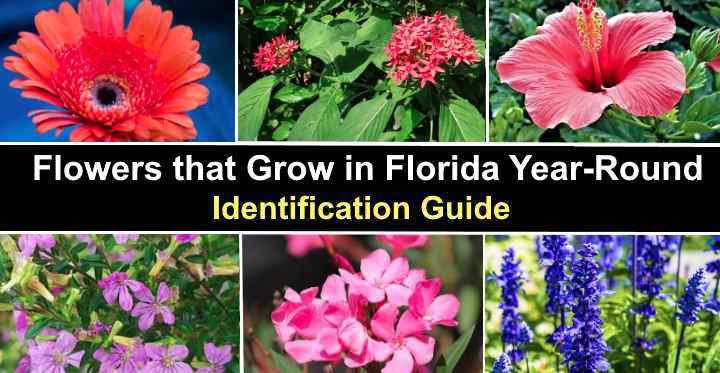
Finding flowers that grow in Florida throughout the year can be challenging. However, growing flowering plants and shrubs that bloom in all seasons in a Florida garden is rewarding. Your front or backyard can be filled with colorful tropical plants blooming in pink, red, orange, yellow, white, and purple flowers. In addition, many colorful Florida plants have evergreen foliage, meaning your garden landscape will consistently look lush and healthy.
Choosing suitable flowers for a Florida landscape can be challenging. For example, native Florida plants that thrive in the northern regions may wither in southern Florida’s intense heat and sunshine. Conversely, evergreen flowering plants that thrive in South Florida may die or lose their foliage when the temperature dips below freezing in North Florida.
This article is an identification guide for selecting the best flowering plants for Florida that bloom throughout the year. You’ll also learn some handy landscaping tips for using these beautiful plants in a Florida landscape.
The Best Flowers to Grow in Florida
The Sunshine State is a great place to grow tropical flowers all year long. The best flowers that bloom from January to December in Florida are Chinese hibiscus, ixora, firespike, and Egyptian star flower. Other flowering plants for full sun like lantana, blue daze, and blanket flower bloom for many months of the year in most Florida regions.
Growing Zones in Florida
Florida is divided into four growing zones representing each region’s minimum winter temperatures. This information is crucial in determining which flowering plants to grow in your garden landscape. For example, some evergreen plants in Florida for zones 9 through 11 are tender perennials growing in zone 8.
Here is a short guide to growing flowers in Florida’s four USDA hardiness zones:
USDA Zone 8: The northernmost region of Florida, which includes Pensacola in the panhandle to Jacksonville in the east. Zone 8 extends south to just above Orlando. The minimum temperature in winter in Zone 8 is 20°F (-6.6°C).
USDA Zone 9: Central Florida is mostly in zone 9. It extends from Orlando to Lake Okeechobee and has a subtropical and tropical climate. The minimum temperature in winter is 25°F (-3.8°C).
USDA Zone 10: Most of southern Florida, from Fort Myers and Naples in the west to Vero Beach, West Palm Beach, and Miami in the east. The minimum temperature range in zone 10 is 30°F to 35°F (-1.1°C – 1.7°C).
USDA Zone 11: This is the southernmost part of Florida and includes the Florida Keys to Key West. Here it doesn’t get colder than 40°F (4.4°).
It’s vital to remember that USDA growing zones are just a rough guide. Proximity to coastal regions or exposed areas can affect a plant’s growth.
Flowers That Grow All Year in Florida (With Pictures and Names) – Identification Guide
Many varieties of native Florida flowers enjoy a long blooming season in the Sunshine State. They are perfect for adding year-long color to tropical landscapes with direct sunlight of at least six hours a day. Please read on to discover the best flowers in Florida that grow all year long.
Chinese Hibiscus (Hibiscus rosa-sinensis)
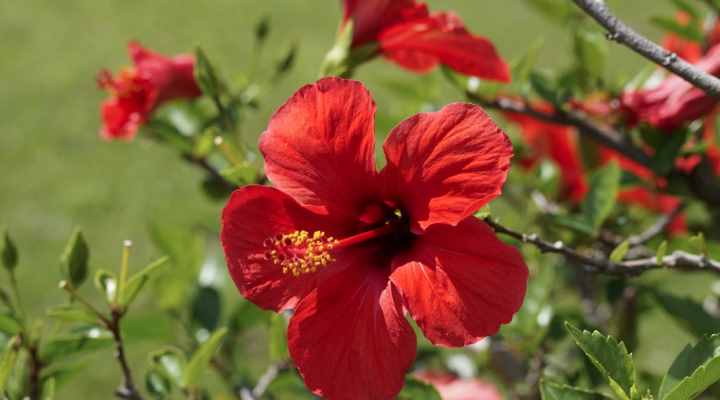
Tropical hibiscus is a sun-loving shrub with colorful large flowers that bloom year-round in south Florida
Also called tropical Hibiscus, this vigorous evergreen shrub has spectacular showy flowers that bloom year-round in Florida in zones 10 and 11. Tropical hibiscus is famous for its large trumpet-shaped flowers with bold protruding stamens. The shrub’s funnel flowers can grow 4” to 8” (10 – 20 cm) wide.
Chinese hibiscus flowers bloom continuously in frost-free areas. The large tropical flowers can be bright red, yellow, white, or shades of pink. These showy blossoms contrast with the shiny green foliage, consisting of large leaves measuring 6” (15 cm) long.
In Florida USDA zones 10 and 11, tropical hibiscus grows as an evergreen flowering shrub. You can use the plant as a privacy screen, flowering hedge, foundation planting, or specimen plant. In Florida’s northern zones, the Chinese hibiscus is ideal for growing in containers to bring color to decks and patios.
Related reading: Tropical Hibiscus: Care and Growing Guide.
Gerbera Daisy (Gerbera garvinea, Gerbera jamesonii)

The bright cheerful gerbera daisy blooms almost all year in the warmer zones of South Florida
Gerbera daisies are colorful Florida flowers that bloom almost continuously in southern Florida. The beautiful long-blooming flowers are multi-petaled flowers with a ray of slender petals surrounding bright centers. Some varieties of gerberas have multi-colored disc-shaped flowers. Other evergreen perennial daisies have ray florets made up of spindly petals.
Gerbera daisies are popular flowering plants for Florida gardens. The daisy flowers bloom from spring to fall in the cooler northern Florida regions in zones 8 and 9. However, in zones 10 and 11, you can enjoy the dazzling floral displays outdoors at any time of the year.
Gerbera daisy flowers can be showy single, semi-double, or double blooms measuring up to 5” (13 cm) across. The rosettes of large slender petals grow at the ends of stems measuring 18” (45 cm) tall. In addition, the daisy plants have lush, mid-green foliage that is semi-evergreen in Florida.
Mexican Heather (Cuphea hyssopifolia)
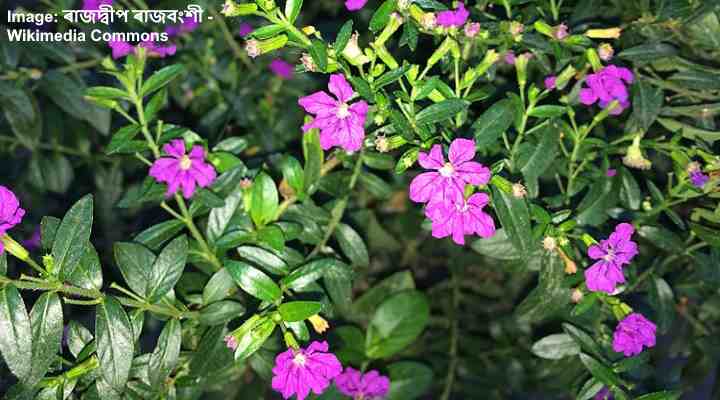
Mexican heather is a hardy shrub that flowers all year-round in most parts of Florida
Mexican heather is a compact evergreen flowering shrub that survives Florida’s hot and humid conditions. This ornamental shrubby plant is identified by its arching stems, low-growth, and masses of lilac, purple-pink, or white flowers blooming much of the year in Florida. In addition, the attractive pointed oval evergreen leaves make this shrub ideal for year-long color in Florida landscapes.
Mexican heather adapts well to various soils and is tolerant of drought and salt. This makes the evergreen shrub ideal for planting in Florida’s coastal regions. In USDA zones 9 to 11, you can plant the shrub as a flowering perennial where it blooms throughout the year. In cooler climates, it’s best to grow the landscaping shrub as an annual.
Mexican heather is characterized by its small, funnel-shaped flowers with six spreading pale purple or pink petals. The shrub blooms profusely almost all year long. You can grow Mexican heather as full sun ground cover, edging for paths or driveways, or in containers.
Egyptian Star Flower (Pentas lanceolata)
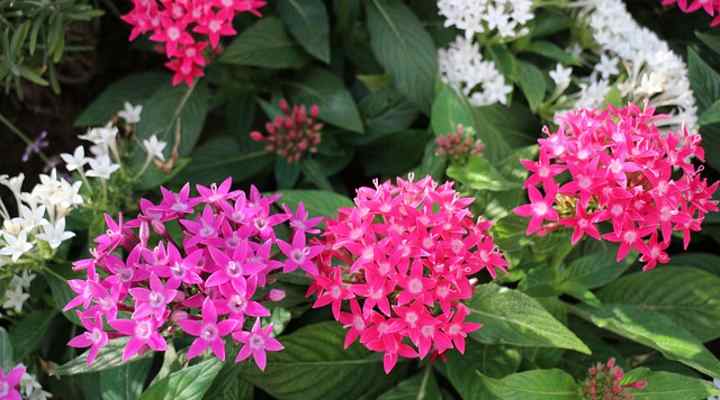
The Egyptian star shrub produces attractive flowers that grow year-round in Florida’s warmer zones
Egyptian star flower is a tall evergreen shrub that produces dense clusters of tiny star-shaped flowers year round in Florida’s warmer zones. The showy flowering clusters are typically pink, lilac, white, or red. As an evergreen perennial in warmer zones, you can expect to see flowers throughout the year, including winter. Penta shrubs grow 3 to 4 ft. (1 – 1.2 m) tall and wide.
Identifying features of Egyptian star flower are its attractive foliage of pointed oval leaves growing 6” (15 cm) long. In addition, the clusters of dainty, five-petaled flowers, and year-long color help to brighten southeastern tropical gardens.
Egyptian star flower shrubs are ideal for planting in a Florida landscape to attract hummingbirds and pollinators. In Central and South Florida, you can expect the flowering shrub to grow year-round. However, in Florida zone 8, the shrubby plant grows best as an annual or tender perennial bedding plant.
Pentas will grow rapidly in full sun or light shade and adapt to most soil types. Some dwarf cultivars are ideal for landscaping small gardens in Florida if you want pink plants growing along a foundation, driveway, or edging a flower bed.
Salvia
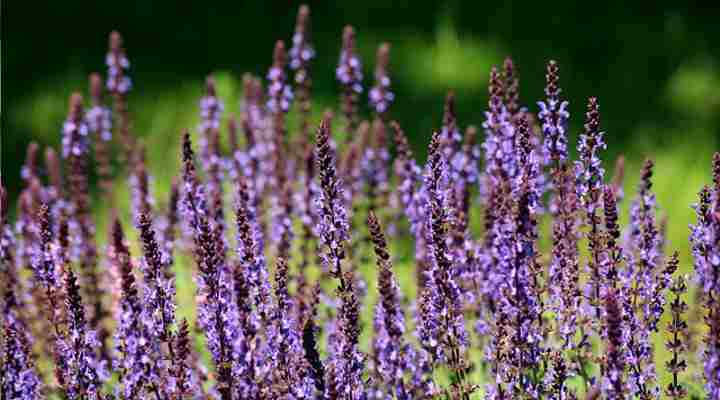
Perennial salvia produces purple flower spikes that bloom throughout the year in central and south Florida
Salvia is an herbaceous purple-flowering perennial plant that blooms throughout the year in frost-free Florida zones. Salvia flowers appear on flowering spikes, and masses of small purple or lilac two-lipped flowers form dense clusters. Another feature of using aromatic salvia shrubs is that they bloom in blue, yellow, white, and pink colors.
Salvia shrubs grow around 18” (45 cm) tall and up to 30” (75 cm) wide. The perennial sun-loving varieties will continue to flower in zones 9 and 10 throughout the year. But in cooler zones, the plant grows as an annual and produces blossoms in the summer.
Salvia is a flowering Florida plant that performs best in full sun. The aromatic leaves provide a fragrant, earthy aroma when crushed. When blooming throughout the summer and into winter, the colorful flowering spikes add a carpet of vibrant colors to a Florida landscape.
Firespike (Odontonema cuspidatum)

Firespike is an all year-round flowering shrub in sunny gardens in south Florida
Firespike is a showy evergreen tropical shrub with green leafy foliage and tall flowering spikes featuring vibrantly-colored red tubular flowers. This small clumping ornamental shrub adds a year-round splash of red colors to southern Florida landscapes. In Central and North Florida, firespike shrubs bloom during fall and winter.
Tropical red-flowering firespike plants grow 4 to 6 ft. (1.2 – 1.8 m) tall. The tall spikes feature cylindrical red flowers measuring 3” (7.5 cm) long. These crimson and lipstick red flowers contrast with the plant’s shiny dark green pointed leaves with wavy margins.
Firespike performs best in full sun and tolerates most soil conditions. It is also tolerant of drought once established. In cooler climates in zone 8, firespike may die back after a frost but return in spring.
Plant firespike in a Florida garden as a foundation planting, massed at the back of a garden bed, or understory for taller landscaping trees.
Ixora
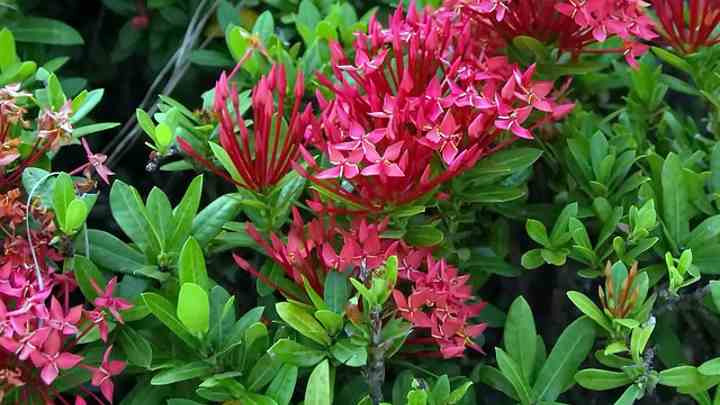
Ixora is an attractive low-maintenance flowering shrub that under ideal conditions blooms all year in south Florida
Ixora is a stunning year-round flowering shrub in South Florida. The attractive landscaping plant has gorgeous clusters of four-petaled red flowers contrasting with the dark green glossy foliage. These long-lasting blooms flower continuously during hot summers and warm winters. The best ixora shrubs for a Florida landscape are dwarf varieties that grow 4 to 6 ft. (1.2 – 1.7 m) tall.
The eye-catching ever-blooming shrub is ideal for Central and South Florida to fill landscapes with red flowers. Apart from red varieties, you can also plant Ixora shrubs with orange, orange-rose, deep red, pinkish-red, and yellow blooms.
Under ideal conditions, ixora shrubs bloom continuously throughout the year. You can also enjoy its lush foliage and wonderfully fragrant flowers when grown in partial shade in Florida. Requiring very little care, ixora is a great addition to warm Florida landscapes.
Knock Out Roses (Rosa ‘Knock Out’)
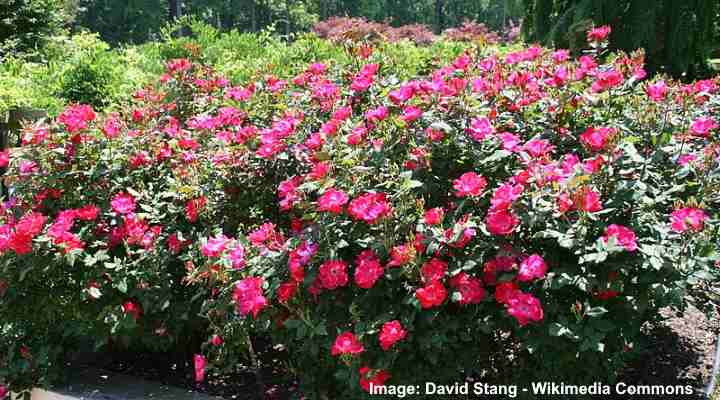
The sun-loving and easy care ‘Knock Out’ roses have beautiful flowers that bloom almost year-round in Florida’s warmer regions
‘Knock Out’ roses are spectacular red, pink, white, and yellow flowers that grow all year long in Florida. The easy-to-grow bushy rose shrubs bloom with double blooms in an open rosette shape. These decorative shrubs bloom almost throughout the year in most regions of Florida.
To get the best results, plant ‘Knock Out’ roses, where they get six to eight hours of sunshine daily. The bushy rose plants will grow 3 to 5 ft. (1 – 1.5 m) tall and wide. After established, the roses require minimal maintenance and will also tolerate some drought, heat, and humidity.
In North Florida, ‘Knock Out’ roses will bloom continuously from spring until frost. In warmer regions, the rose shrubs will produce flowers through winter. You can plant the decorative flowering shrubs as a colorful hedge, foundation plant, or complement perennial shrubs.
Oleander (Nerium oleander)

Oleander is a hardy drought tolerant shrub that flowers most of the year in South Florida
Oleander is a fast-growing evergreen shrub or small flowering tree with long-lasting blooms in Florida. The bushy shrub is known for its pink, purple, or white five-petaled trumpet-shaped flowers growing in small clusters. In warm months in southern Florida, the flowers will grow most of the year.
Oleander has a rounded growth habit and grows 4 to 8 ft. (1.2 – 2.4 m) tall. It produces the most flowers when grown in full sun; however, it will tolerate some shade. Additionally, the shrub is tolerant of drought, sea air, and pollution, making it ideal for landscaping throughout the Sunshine State.
Oleander shrubs thrive in USDA zones 9 through 11. However, it’s good to note that the plant may suffer damage in the cooler regions of zone 9. You can also train the suckering shrub to grow as an ornamental flowering tree by regularly removing the suckers.
It’s important to remember that all parts of oleander plants are toxic. Therefore, it’s best to avoid them in the landscape if pets or children play in the yard.
Flowers that Grow Most of the Year in Florida
Several other varieties of full-sun Florida flowers have long blooming times despite Florida’s harsh climate. While some varieties don’t flower during all the four seasons, there are colorful varieties of plants that grow for most of the year in Florida. Read on to learn about some of the best Florida plants for your landscape.
Blanket Flower (Gaillardia)
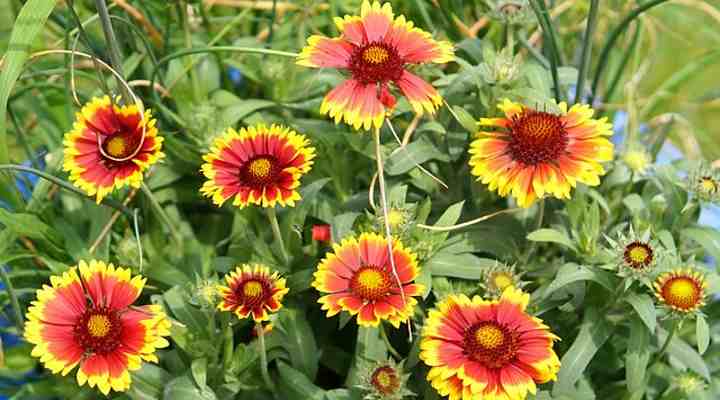
The beautiful blanket flowers have a long blooming season and give a bright focal point to Florida gardens
Blanket flower is a sturdy perennial mounding plant with brightly colored daisy-like flowers that bloom from early summer through late fall. Blanket flowers are generally a ray of orange and yellow finger-like petals surrounding a dark center. These eye-catching bright flowers bloom on the end of wiry stems.
Blanket flowers are ideal for growing throughout Florida as they are suitable for USDA zones 2 through 11. Plant the flowers in well-drained soils and full sun for the best effect. In addition, because blanket flowers are salt-tolerant, they are ideal for coastal landscapes along the Gulf Coast or Atlantic coast.
The cultivar Gaillardia aestivalis is a flowering plant native to Florida. It has distinctive yellow rays that grow sparsely around the dark brown center. In addition, this native Florida plant has lanceolate gray-green leaves. The yellow flowers are ideal for Florida landscapes as perennial border fronts, foundation plantings, and for mixed beds.
Blue Daze (Plumbago)
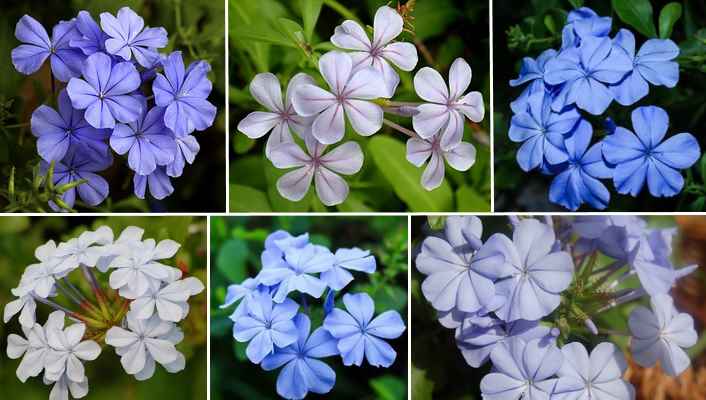
Plumbago flowers come in shades of blue, purple and white and bloom almost all year in Central and South Florida
Plumbago is a low-maintenance blue-lilac or white-flowering herbaceous plant that blooms throughout most of the year in sunny Florida landscapes. Plumbago plants are identified by their attractive five-petaled flowers with spoon-shaped or oval petals. These flowers contrast nicely with the light green, obovate leaves. In addition, its mounding growth with trailing stems creates an attractive landscaping plant.
Blue daze blooms freely from spring through summer in temperate regions. However, in Central and South Florida, the sprawling shrub produces flowers for almost the whole year. The sizable flowering shrub grows up to 10 ft. (3 m) tall and wide.
Also called cape leadwort, you can grow blue daze in a hot, humid climate, and it’s ideal for sun-tolerant ground cover with purple-blue flowers. However, you can also grow the beautiful shrub over a trellis, arbor, pergola, or cascading over a wall. Its blue flowers and bright green foliage have eye-catching visual appeal.
Lantana
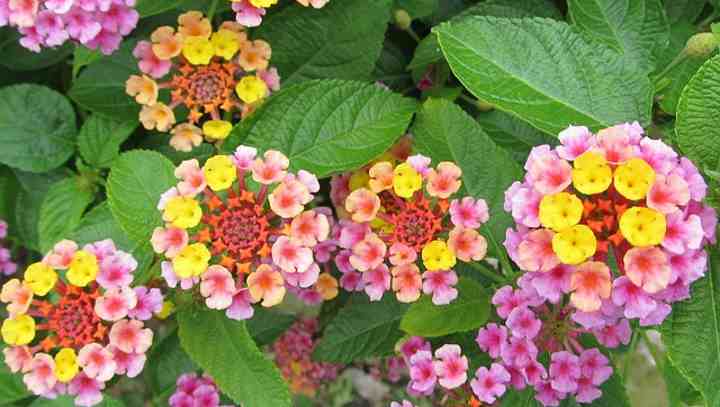
The colorful lantana flowers grow well in the tropical area of south Florida and bloom most of the year
Lantana is a popular landscaping shrub in Florida because it grows best in hot summer climates and warm winters. The small shrub, with its clusters of colorful flowers, thrives in full sun. In Central and South Florida, you can enjoy its colorful blooms for most of the year.
These low-growing flowering shrubs perform best in sandy, loamy soil and thrive in full sun. In addition, lantanas are tolerant of salt and heat, making the plants ideal for Florida’s coastal regions.
There are several varieties of Lantana that thrive in Florida. The rounded flower clusters consist of small cup-shaped flowers, and many blooms are multi-colored. There are flower color combinations of pink and yellow, red and yellow, yellow and orange, and pure pink.
Lantana flowers are suitable for growing year-round outdoors in Florida zones 8 through 10.
Bulbine (Bulbine frutescens)
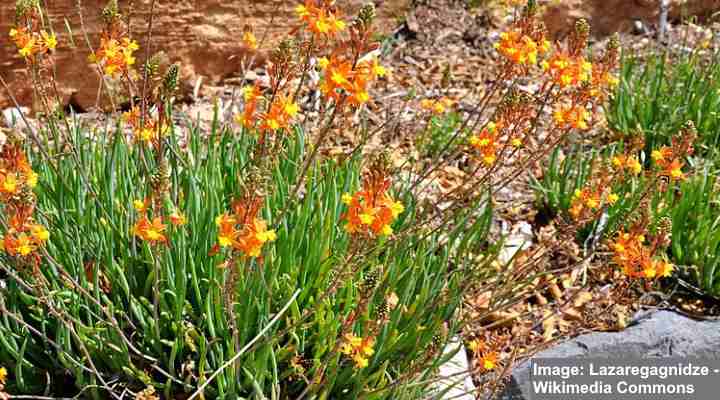
Bulbine is a common flowering perennial plant in Florida that blooms during the warm months
Bulbine is a non-native flowering perennial plant popular in Florida because it’s non-invasive and thrives in heat and poor soils. Bulbine is identified by its long flowering stalk with dainty yellow-orange flowers that bloom throughout the warm months. In addition, the grass-like foliage creates cheerful mounds, ideal for small to medium-sized yards.
Also called orange bulbine, the charming heat-loving plant grows on average 1 to 1.5 ft. (0.3 – 0.45 m) tall. Its branched, stout stems grow up to 1 ft. (30 cm) tall, and its flowering stalks grow up to 2 ft. (60 cm) and are covered with small six-petaled pale orange or yellow flowers.
You can plant bulbine as ground cover in a sunny Florida yard or use it to brighten mixed border fronts, line pathways, or landscape rock gardens. Due to its tolerance to heat and drought, it’s also an ideal plant for xeriscaping.
Related articles:
- Florida Flowers (Native and Non-Native)
- The Best Shrubs for Florida
- The Best Flowering Trees in Florida
